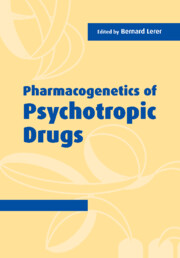Crossref Citations
This Book has been
cited by the following publications. This list is generated based on data provided by Crossref.
Ozdemir, Vural
and
Lerer, Bernard
2005.
Pharmacogenomics, Second Edition.
Vol. 20052733,
Issue. ,
p.
13.
Lerer, Bernard
and
Segman, Ronnen H.
2006.
Pharmacogenetics of antipsychotic therapy: pivotal research issues and the prospects for clinical implementation.
Dialogues in Clinical Neuroscience,
Vol. 8,
Issue. 1,
p.
85.
Maier, W.
Zobel, A.
and
Schwab, S.
2008.
Psychiatrie und Psychotherapie.
p.
71.
Bakker, P R
van Harten, P N
and
van Os, J
2008.
Antipsychotic-induced tardive dyskinesia and polymorphic variations in COMT, DRD2, CYP1A2 and MnSOD genes: a meta-analysis of pharmacogenetic interactions.
Molecular Psychiatry,
Vol. 13,
Issue. 5,
p.
544.
Maier, W.
and
Rujescu, D.
2011.
Psychiatrie, Psychosomatik, Psychotherapie.
p.
127.
Bakker, P. Roberto
Bakker, Egbert
Amin, Najaf
van Duijn, Cornelia M.
van Os, Jim
van Harten, Peter N.
and
Zhang, Xiang Yang
2012.
Candidate Gene-Based Association Study of Antipsychotic-Induced Movement Disorders in Long-Stay Psychiatric Patients: A Prospective Study.
PLoS ONE,
Vol. 7,
Issue. 5,
p.
e36561.
Koning, Jeroen P.
Vehof, Jelle
Burger, Huibert
Wilffert, Bob
Al Hadithy, Asmar
Alizadeh, Behrooz
van Harten, Peter N.
and
Snieder, Harold
2012.
Association of two DRD2 gene polymorphisms with acute and tardive antipsychotic-induced movement disorders in young Caucasian patients.
Psychopharmacology,
Vol. 219,
Issue. 3,
p.
727.
Bakker, P. Roberto
Al Hadithy, Asmar F. Y.
Amin, Najaf
van Duijn, Cornelia M.
van Os, Jim
van Harten, Peter N.
and
Toft, Mathias
2012.
Antipsychotic-Induced Movement Disorders in Long-Stay Psychiatric Patients and 45 Tag SNPs in 7 Candidate Genes: A Prospective Study.
PLoS ONE,
Vol. 7,
Issue. 12,
p.
e50970.
Huefner, Jonathan C.
Griffith, Annette K.
Smith, Gail L.
Vollmer, Dennis G.
and
Leslie, Laurel K.
2014.
Reducing Psychotropic Medications in an Intensive Residential Treatment Center.
Journal of Child and Family Studies,
Vol. 23,
Issue. 4,
p.
675.
Maier, W.
Giegling, I.
and
Rujescu, D.
2016.
Psychiatrie, Psychosomatik, Psychotherapie.
p.
1.
Carlo, Andrew D.
and
Alpert, Jonathan E.
2016.
Clinically Relevant Complications of Drug-Food Interactions in Psychopharmacology.
Psychiatric Annals,
Vol. 46,
Issue. 8,
p.
448.
Maier, Wolfgang
Giegling, Ina
and
Rujescu, Dan
2017.
Psychiatrie, Psychosomatik, Psychotherapie.
p.
147.
Maier, W.
Giegling, I.
and
Rujescu, D.
2017.
Psychiatrie, Psychosomatik, Psychotherapie.
p.
1.
Patel, Manvendra
Kumar, Rahul
Kishor, Kamal
Mlsna, Todd
Pittman, Charles U.
and
Mohan, Dinesh
2019.
Pharmaceuticals of Emerging Concern in Aquatic Systems: Chemistry, Occurrence, Effects, and Removal Methods.
Chemical Reviews,
Vol. 119,
Issue. 6,
p.
3510.
van der Burg, Nadine C.
Al Hadithy, Asmar F. Y.
van Harten, Peter N.
van Os, Jim
and
Bakker, P. Roberto
2020.
The genetics of drug-related movement disorders, an umbrella review of meta-analyses.
Molecular Psychiatry,
Vol. 25,
Issue. 10,
p.
2237.



